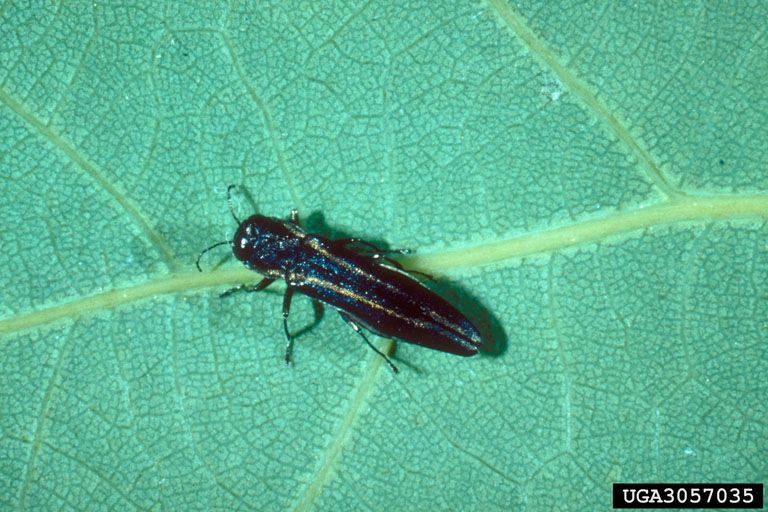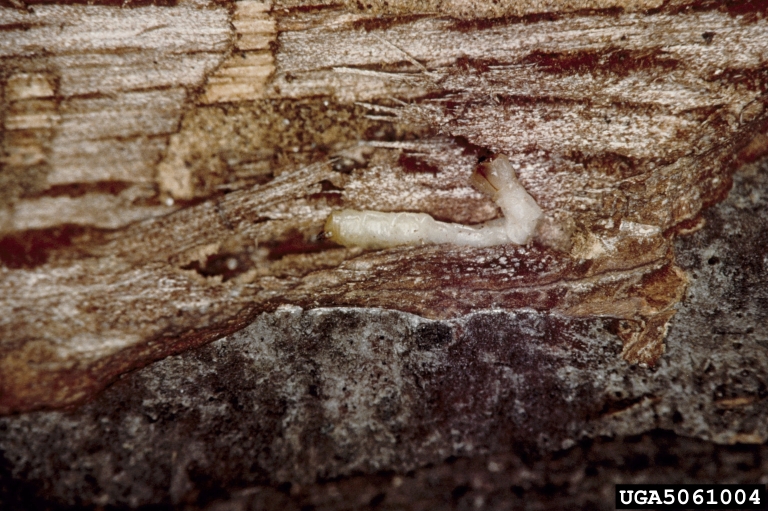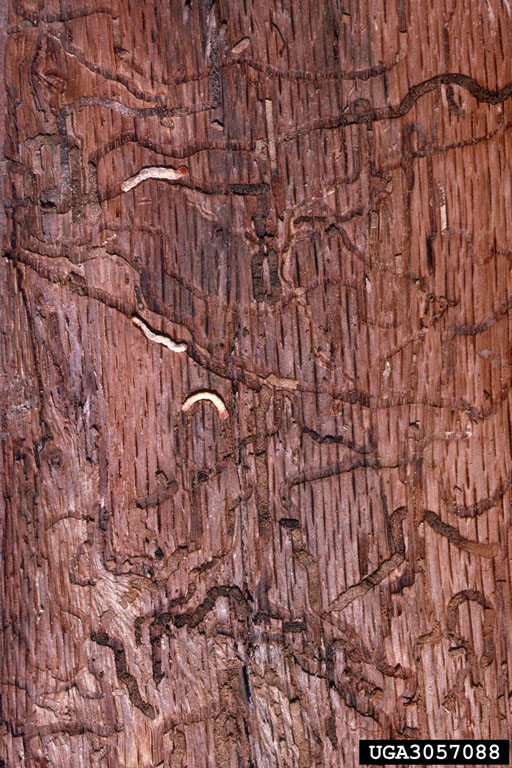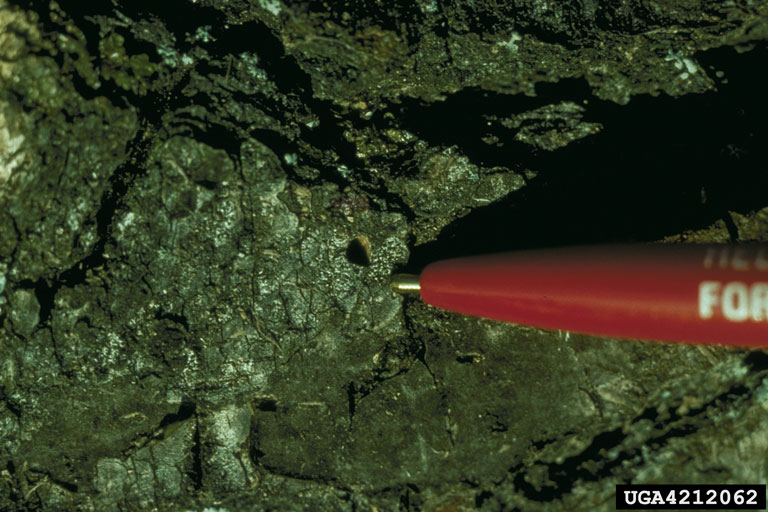Not present in United Kingdom
Reportable – see ‘Report a sighting’ below
Scientific name – Agrilus bilineatus (A. bilineatus)

Picture: Robert A. Haack, USDA Forest Service, Bugwood.org
The larvae, or grubs, of two-lined chestnut borer beetles are a pest of sweet chestnut (trees in the Castanea genus) and oak trees (Quercus genus).
Two-lined chestnut borer is native to mid- and eastern North America, and it is believed to have become established in Turkey. See ‘Origins and background’ below for more detailed information.
Two-lined chestnut borer has been recorded on American sweet chestnut (Castanea dentata), and numerous species of oak, including the UK’s native ‘English’ or pedunculate oak (Q. robur).
Although the pest’s common name associates it with chestnut trees, oak trees are in fact its main host plant, and imports of oak wood and plants probably present the greatest risk of introducing the pest into the UK. It is thought that it is likely to be able to attack all species of oak, including the UK’s other native species, sessile oak (Q. petraea).
There is no information about the susceptibility of European sweet chestnut (C. sativa) because it is not widely grown in North America. However, we believe it is reasonable to presume that European sweet chestnut is as susceptible as its American relative. The stress of infection by pathogens such as Cryphonectria parasitica, which causes sweet chestnut blight and which is present in the UK, might increase the susceptibility of European sweet chestnut.
Oak trees play significant roles in our rural economy, landscape, biodiversity, ecology, environment and culture. Oak timber is one of our most valuable woodland products, and many businesses and jobs depend on it to some extent. In the UK, oak trees provide habitat for more other species than any other species of tree.
The UK’s oak trees are already under pressure from a number of threats. These include acute oak decline, chronic oak decline, two-spotted oak buprestid beetles (Agrilus biguttatus), oak processionary moth (Thaumetopoea processionea) and extreme weather events such as droughts, which are likely to become more frequent and severe as the climate changes. An accidental introduction to the UK of the oak wilt fungus Ceratocystis fagacearum, or one or both of the North American variants of the Phytophthora ramorum water mould, could pose another serious threat to our oaks.
Although two-lined chestnut borer is mostly a secondary pest, preferring to infest trees which have already been weakened by other stress events, it has been reported to also infest and kill healthy trees. And although the species does not itself damage the heartwood, other pests in the UK and continental Europe, such as oak pinhole borer (Platypus cylindrus), invariably take advantage of the tree’s weakened state to do so. This renders the timber less useable, and thereby reduces its value.
Research evidence from the University of Michigan suggests that English/pedunculate oak trees of certain provenances are particularly susceptible to attack by two-lined chestnut borer. Furthermore, it suggests that European oak species in general are more susceptible than their North American relatives, which have had the benefit of co-evolution with the beetle over many centuries.
Although not as widespread, numerous and important as oak, sweet chestnut, most of which is grown in southern England, is similarly under pressure. Existing UK threats include sweet chestnut blight (caused by the fungus Cryphonectria parasitica), Oriental chestnut gall wasp (Dryocosmus kuriphilus) and Phytophthora ramorum.
A pest risk analysis has been conducted by the European & Mediterranean Plant Protection Organization (EPPO). It concluded that the European climate is unlikely to hinder the pest’s ability to become established in Europe if it was accidentally introduced. EPPO has therefore identified it as a serious threat, and recommended that member countries legislate to prevent its accidental introduction and spread in movements of plants, timber, and wood products and packaging. See ‘Regulation and official action’ below for details of the UK’s response.
The adults (beetles, top picture) are between 6 and 12 mm (0.2-0.5 inches) long, and slender. They are black, with a light, yellowish stripe on each wing cover, giving rise to its name. It is most likely to be seen in late spring and early summer.

Picture: Joseph O’Brien, USDA Forest Service, Bugwood.org
The larvae (above) are white, slender, flattened, and about 25 mm (1 inch) long, with two spines at the rear end.

Picture: James Solomon, USDA Forest Service, Bugwood.org
Symptoms of the pest’s presence in a tree include winding ‘mines’ or galleries (above, with larvae present) excavated by the larvae in the inner bark and outer sapwood of the main trunk and large branches. These mines frequently girdle the tree, and are visible after peeling off the bark. Attacks usually begin in the upper tree canopy and extend downwards as the tree progressively weakens.

Picture: Minnesota Department of Natural Resources – FIA, Bugwood.org
D-shaped holes in the bark (above) where the adult beetles emerge after pupation are also a sign of infestation, although these can be difficult to detect, especially in large trees. However, other Agrilus species also make D-shaped holes in oak, so samples would be needed for identification.
More pictures of the pest and its symptoms are available on www.forestryimages.org.
Although two-lined chestnut borer is not thought to be present in the UK, there is a risk of it being accidentally introduced. We therefore encourage tree and ground-care professionals, oak and sweet chestnut tree owners and managers, and the public, to be vigilant for signs of it and to report suspected sightings immediately.
People receiving or handling imported oak and sweet chestnut planting material and wood or wood products should be especially vigilant.
Please note that TreeAlert and TreeCheck both require photographs to be uploaded. These should be clear, well-lit, close-up pictures of symptoms.
Alternatively, suspected sightings can be made directly to the relevant plant health authority. This is the preferred route for suspected sightings made on trade premises, such as nurseries and garden centres.
In all cases, provide precise details of the location and, if possible, clear, well lit, close-up photographs of the pest or the symptoms of its presence.
Two-lined chestnut borer is a member of the sub-family Buprestidae of wood-boring beetles, which are also known as ‘jewel’ beetles because of their glossy, iridescent colours.
The adults oviposit (lay their eggs) singly or in clusters of up to 10 in cracks and crevices in the bark of oak or sweet chestnut trees. They prefer stressed trees, but will also attack healthy trees. Oviposition typically occurs anywhere from the base of the trunk to branches with a diameter as small as 2 cm (0.8 in).
Larvae hatch and immediately tunnel into the bark, entering the cambial region and scoring both the inner bark and outer sapwood. They can grow to between 18 and 24 mm long (0.75-0.95 in). The galleries they make in the phloem and outermost xylem tissues can eventually girdle the tree, starving it of fluid and nutrients, leading to crown dieback and tree death. (The phloem and xylem tissues conduct nutrients from the leaves, and fluids from the roots, to the rest of the tree.)
Pupae, the next stage of the life cycle, are 6 to 10 mm (0.25-0.4 in) long and occur just under the bark surface.
When the adult emerges from the pupa it requires a few days for its cuticle to harden before it emerges from the tree, leaving the D-shaped exit hole typical of Agrilus species. Adults tend to emerge in late spring and early summer, although some adult activity can continue into August and September.
Upon emergence, the adults fly to the top of the tree to feed on leaves, which they need to do to become sexually mature. They then mate and lay eggs to start the life cycle of the next generation.
The entire life cycle is usually complete within a year, but in some cases it might take two years.
Adults are thought to be strong flyers, but dispersal has not been studied: presumptions are made based on the known dispersal rates of emerald ash borer (Agrilus planipennis) and bronze birch borer (A. anxius).
As of September 2020 the UK Government was planning regulations to classify two-lined chestnut borer as a quarantine pest for England. These will enable it to impose controls on imports of oak and chestnut materials which pose a risk of introducing the pest into England. They were expected to be included in the legislative update programme early in 2021. The Devolved Administrations in Scotland, Wales and Northern Ireland were expected to take similar action.
The Forestry Commission has prepared a contingency plan which would guide official action if an outbreak (breeding population) of the pest was found in the UK.
Two-lined chestnut borer was first identified as being a serious threat during an EPPO pest risk analysis workshop on Agrilus fleischeri, which is an emerging pest of willow and poplar trees in China, and two-lined chestnut borer in December 2018. It was added to the EPPO Alert list in 2018, and in 2019 it was moved to the EPPO A2 list of pests recommended for regulation as quarantine pests.
Widespread population spikes in the USA and Canada have frequently followed periods of severe drought, defoliation, ice storms and late spring frosts which have stressed and weakened oak and sweet chestnut trees.
Historically, high numbers of tree deaths have been attributed to two-lined chestnut borer, and it has been noted as being one of the principal factors contributing to the deaths of weakened oaks in eastern North America.
It is not known when or how it was introduced to Turkey, where there have been four reports of its presence at sites near Istanbul and the Bulgarian border since 2002. Although significant damage has not yet been recorded in Turkey, this might simply be because the population there is still too low.